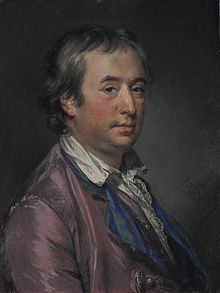William Chambers (architect)
| Sir William Chambers | |
|---|---|

William Chambers, painted in 1764 by Frances Cotes
|
|
| Born | 23 February 1723 Gothenburg, Sweden |
| Died | 10 March 1796 London, England |
| Nationality | Scottish |
| Occupation | Architect |
| Buildings |
Casino at Marino Dundas House (now the headquarters of the Royal Bank of Scotland) Dunmore Pineapple Somerset House |
Sir William Chambers RA (23 February 1723 – 10 March 1796) was a Scottish-Swedish architect, based in London. Among his best-known works are Somerset House, London, and the pagoda at Kew. Chambers was a founder member of the Royal Academy.
William Chambers was born on 23 February 1723 in Gothenburg, Sweden, to a Scottish merchant father.
Between 1740 and 1749 he was employed by the Swedish East India Company making three voyages to China where he studied Chinese architecture and decoration.
Returning to Europe, he studied architecture in Paris (with J. F. Blondel) and spent five years in Italy. Then, in 1755, he moved to London, where he established an architectural practice. Through a recommendation of the John Stuart, 3rd Earl of Bute in 1757 he was appointed architectural tutor to the Prince of Wales, later George III, and in 1766 also, along with Robert Adam, Architect to the King, (this being an unofficial title, rather than an actual salaried post with the Office of Works). He worked for Augusta, Dowager Princess of Wales making fanciful garden buildings at Kew, and in 1757 he published a book of Chinese designs which had a significant influence on contemporary taste. He developed his Chinese interests further with his Dissertation on Oriental Gardening (1772), a fanciful elaboration of contemporary English ideas about the naturalistic style of gardening in China.
His more serious and academic Treatise on Civil Architecture published in 1759 proved influential on builders; it went into several editions and was still being republished in 1826. It dealt with the use of the classical orders, and gave suggestions for decorative elements, rather than dealing with construction and planning; for its third edition it was retitled A Treatise on the Decorative Parts of Civil Architecture. It included ideas from the works of many 16th- and 17th-century Italian architects then still little known in Britain. His influence was also transmitted through a host of younger architects trained as pupils in his office, including Thomas Hardwick (1752–1825), who helped him build Somerset House and who wrote his biography.
...
Wikipedia
